SB Television
Spectacular Yellowfin Fishing in Panama’s Gulf of Chiriqui
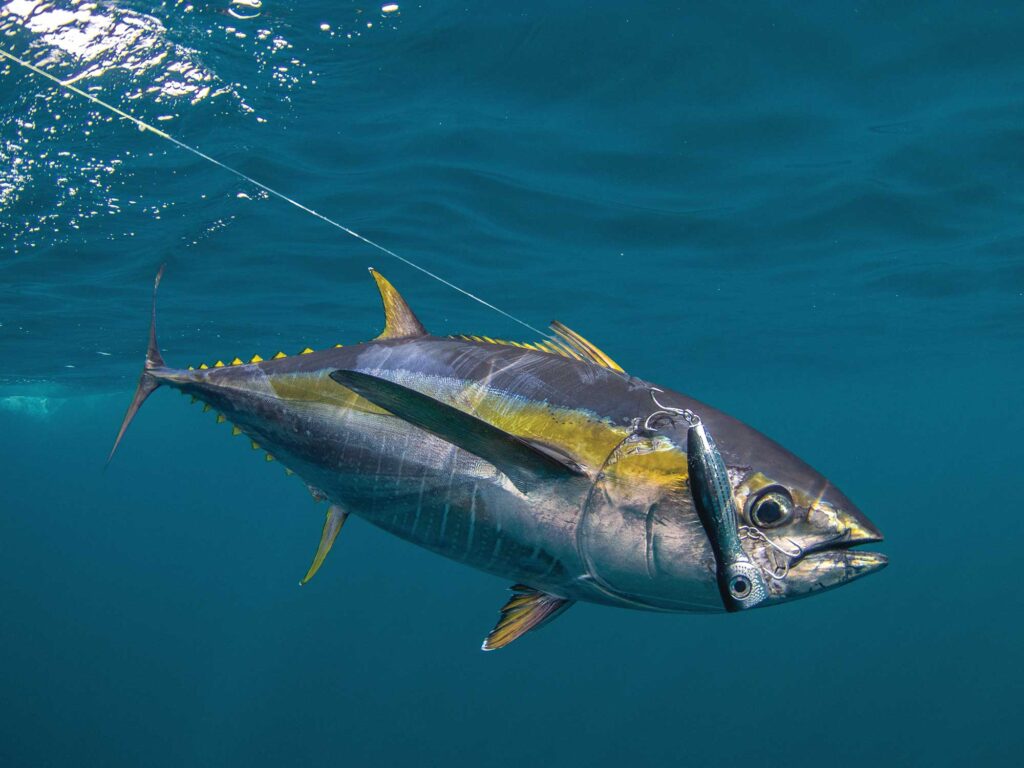 Yellowfin tuna, along with black marlin, blue marlin, wahoo, dorado and sailfish, are the Gulf of Chiriqui’s marquee offshore species.
Adrian Gray
Yellowfin tuna, along with black marlin, blue marlin, wahoo, dorado and sailfish, are the Gulf of Chiriqui’s marquee offshore species.
Adrian Gray
“Hang on guys!” Those who fish Sport Fish Panama Island Lodge quickly come to appreciate these words. When Capt. Shane Jarvis says them, it’s an indication he’s about to drive on tuna.
We’re here in mid-May, peak season for yellowfins. The tuna haven’t disappointed. The fish are up top today—as they’ve been often, lately—in fast-moving frenzies of birds, bait and tuna. On the MFD, the Simrad Halo 24″ showed a mark of birds about a mile away. It’s concentrated and stable; this part of the world is perfect for bird mode.
We run toward the mark, wide open. When we’re a quarter-mile out, the spectacle becomes evident. Hundreds of birds—boobies diving and frigates swooping—work the bait. In the epicenter of activity, where the birds enter the water, yellowfins crash the surface around a floating pallet. A baitball huddles around it, attempting to take shelter from the hundreds of tuna and scores of porpoises.
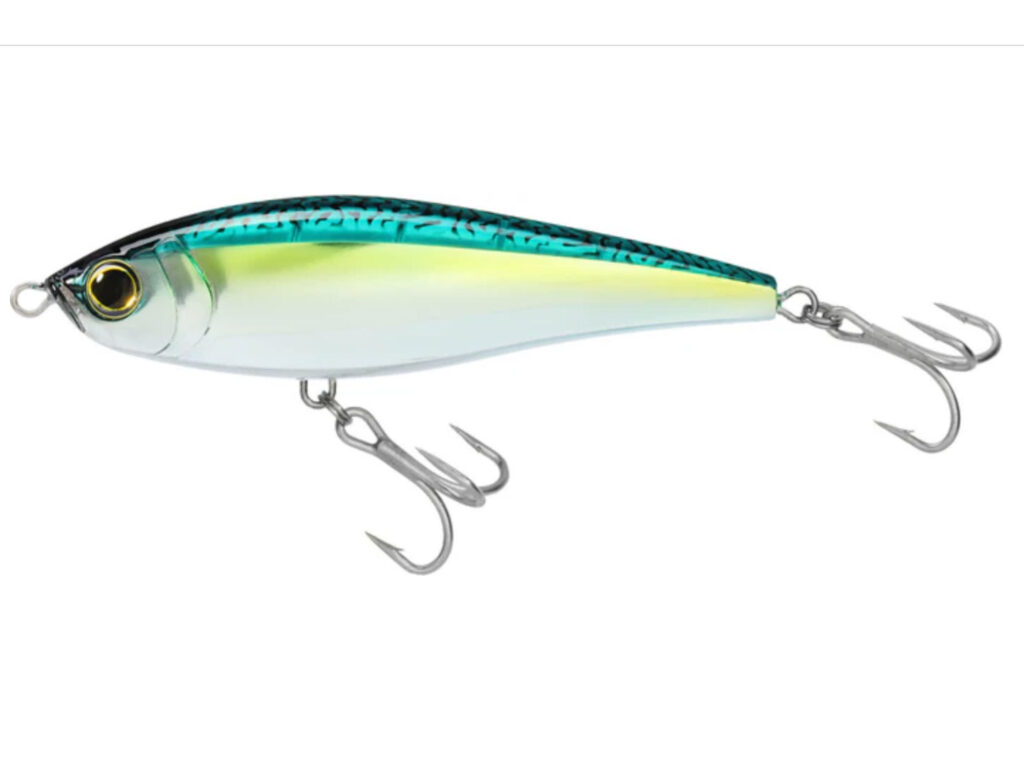 Yo-Zuri’s Hydro Twitchbait is a good option when tuna are looking for something below the surface.
Yo-Zuri
BUY NOW
Yo-Zuri’s Hydro Twitchbait is a good option when tuna are looking for something below the surface.
Yo-Zuri
BUY NOW
We can see that some of the terrified prey—small blue runners and assorted triggerfish—have ended up atop the pallet, completely out of the water, where the birds pick them off easily. Tuna crash the water immediately surrounding the pallet in concentric circles, the biggest about 10 yards in diameter. Every once in a while, a bait is thrown into the air 6 or 8 feet high by attacking yellowfins. The majority of the tuna range from 40 to 80 pounds, but there are some bigger ones in the mix, their presence betrayed by the size of the explosions they create in the water.
“Hang on guys!” Jarvis warns as he drives the boat with determination, easing back on the throttle only as the boat glides in close to the action. His fleet consists of four 33-foot catamarans—three World Cats and one Freeman—all ideal for this type of fishing. Fast and maneuverable, with casting platforms on the bows, the boats have long, open rails and generous cockpits.
By the time the cat’s forward momentum has faded, two Yo-Zuri Mag Poppers and a stickbait are flying toward the chaos. Within 60 seconds, we have five rods hooked up and photographer Adrian Gray in the water. In most any other part of the world, this tuna spectacle might be once in a lifetime. Here, it’s business as usual.
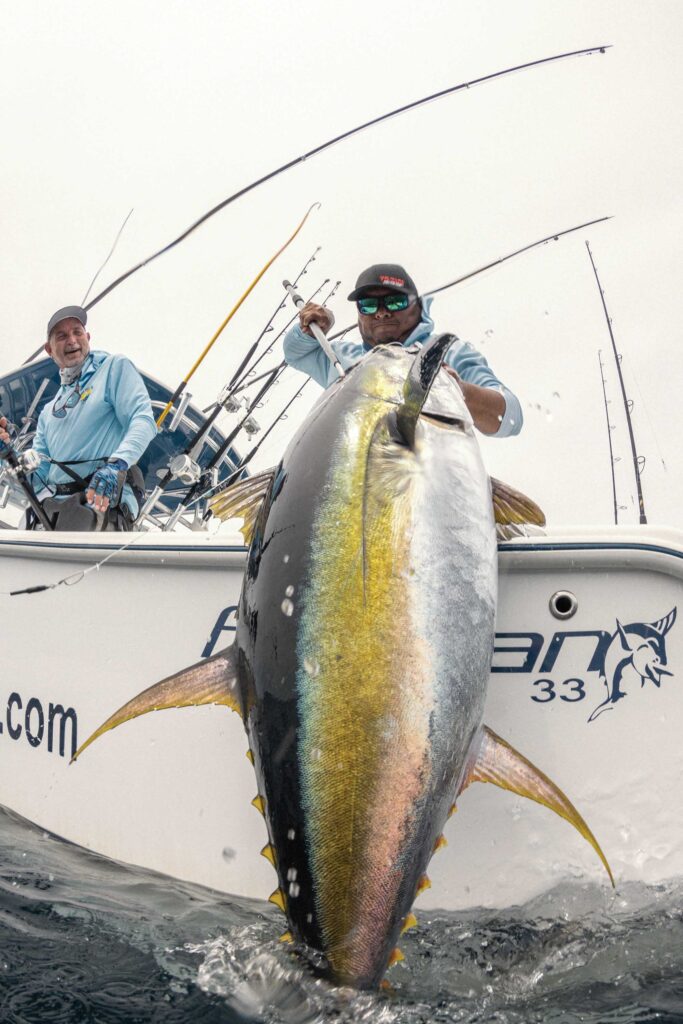 Typical Chiriqui yellowfins range from 40 to 80 pounds, with some reaching triple digits.
Adrian Gray
Panama’s Gulf of Chiriqui
Typical Chiriqui yellowfins range from 40 to 80 pounds, with some reaching triple digits.
Adrian Gray
Panama’s Gulf of Chiriqui
Although still a hidden gem for many fishermen, Panama’s Gulf of Chiriqui is increasingly known to serious traveling anglers. Concentrations of black marlin and large yellowfins around Coiba Island, Hannibal Bank and Isla Montuosa have been drawing folks to this part of the world since The Madam and The Hooker days of the early 1980s. The black marlin fishing can be great here, and the yellowfin fishery, in terms of consistency, size and abundance, is among the best in the world. That said, there is much more to this place than the abundant pelagics.
Jarvis, who owns the Sport Fish Panama Island Lodge, has been fishing here since 2005. The operation has helped make the Gulf of Chiriqui and the great diversity of fishing options central to the appeal of these waters.
That makes the Gulf of Chiriqui a great place for anglers wishing to add to their species tally. If you put in your time, and things line up correctly, you could realistically catch 15 species of fish during a visit here. Offshore, there’s black marlin, blue marlin, big Pacific sailfish, yellowfin tuna, dorado and wahoo. Inshore, big roosterfish and cubera snapper await, and much more. You can catch amberjack, mullet snapper, rock snapper, bluefin trevally, jack crevalle, horse-eye jacks, gigantic needlefish, Sierra mackerel, broomtail grouper and others. Lodge boats even catch the occasional tarpon. You can jig or drop bait on deepwater structure for a variety of grouper and snapper that inhabit the depths. (Nobody has ever been unhappy to eat a snowy.)
The many species available here (many trophy-size) are just part of what makes the Gulf of Chiriqui special. Chiriqui offers a variety of targets and the ability to integrate them into the same day of fishing, whether offshore or inshore. This characteristic is a function of the region’s geography. Sport Fish Panama Island Lodge sits on the eastern shoreline of Isla Parida. From where the boats are moored, it’s about 40 miles to Coiba Island. Between Coiba and Isla Parida sit hundreds of islands and rocky pinnacles, along with deep blue water.
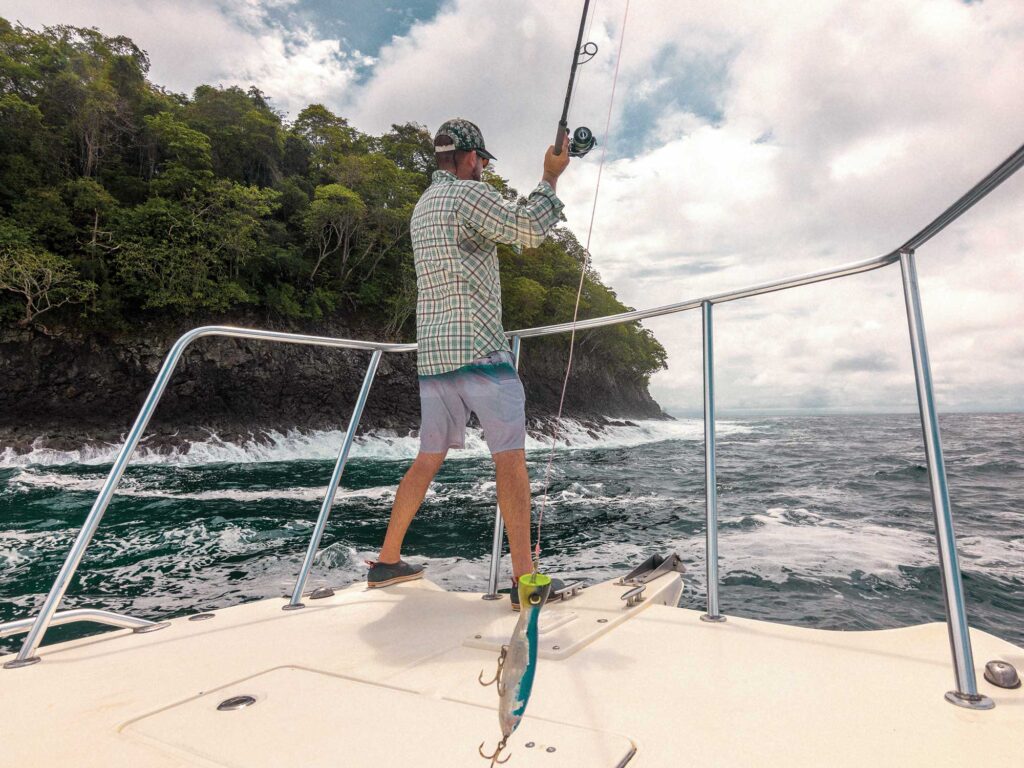 The Sport Fish Panama Island Lodge fleet features 33-foot catamarans with spacious casting decks on the bows.
The Sport Fish Panama Island Lodge fleet features 33-foot catamarans with spacious casting decks on the bows.
In places like Islas Ladrones (17 miles from the lodge) and Isla Montuosa, rocky shorelines and underwater structure sit in close proximity to the open Pacific. As a result, you can be live-baiting for black marlin or casting poppers into bodies of busting yellowfin tuna within sight of some of the most productive inshore habitat you can imagine. It is this concentration of habitat that makes the Gulf of Chiriqui such a unique fishery. Other locations might offer good inshore and offshore opportunities, but typically, the best spots to catch pelagics and coastal species might be physically separated by 40 to 50 miles or more.
Even though it’s situated so close to offshore fishing grounds, the inshore fishing in the Gulf of Chiriqui is very productive. Were it not for the incredible tuna fishing and presence of big black marlin, inshore action would take top billing. The consistent presence of large roosterfish and big cubera snapper lurking around pinnacles and rocky shorelines has been attracting anglers to this part of the world for decades. This area is among the best in Central America to catch 40-plus-pound cuberas and roosterfish, and Jarvis’ team has caught both species as large as 80 pounds.
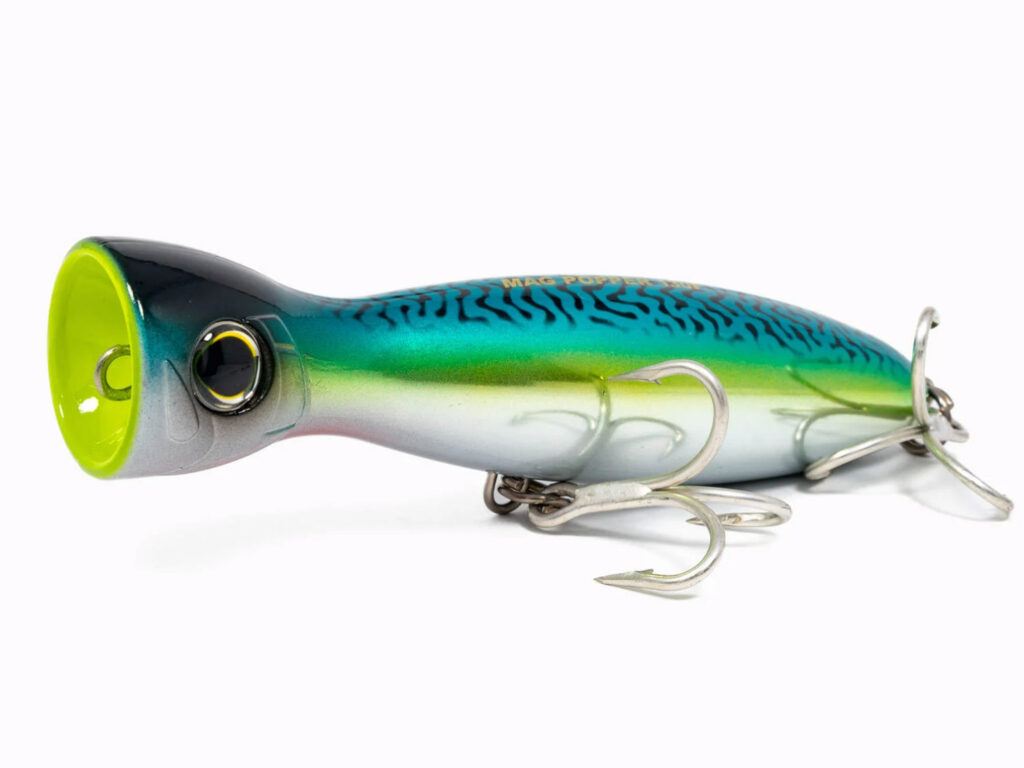 A Yo-Zuri Mag Popper incites crazy topwater action, both inshore for roosters and offshore for yellowfin tuna.
Yo-Zuri
BUY NOW
A Yo-Zuri Mag Popper incites crazy topwater action, both inshore for roosters and offshore for yellowfin tuna.
Yo-Zuri
BUY NOW
I recall an inshore-nearshore day perched on the casting platform of one of Sport Fish Panama Island Lodge’s catamarans, casting poppers as close to the wash of a rocky shoreline as I could get. Around Islas Ladrones, the clear, blue ocean water bounces off deep-brown boulders that jut from the sea. The wash is white and blue, equal parts air and ocean, where poppers loudly make their presence known as they call up the creatures that prowl beneath. The crest of a roosterfish in frothy water or the explosion of a cubera from the calm surface just past the zone where the waves break are sights that will stay with me long after I’ve left.
In addition to the big fish inshore, the natural beauty is intense. Coiba Island is a national park and a United Nations World Heritage Site. The seascapes are as uniquely beautiful as they are productive. A United Nations publication explains the appeal, pointing to incomparable beauty in “a wide range of environments and resulting habitats” thanks to the proximity “of both a continental and oceanic influence.”
Read Next: Panama’s Topwater Yellowfins
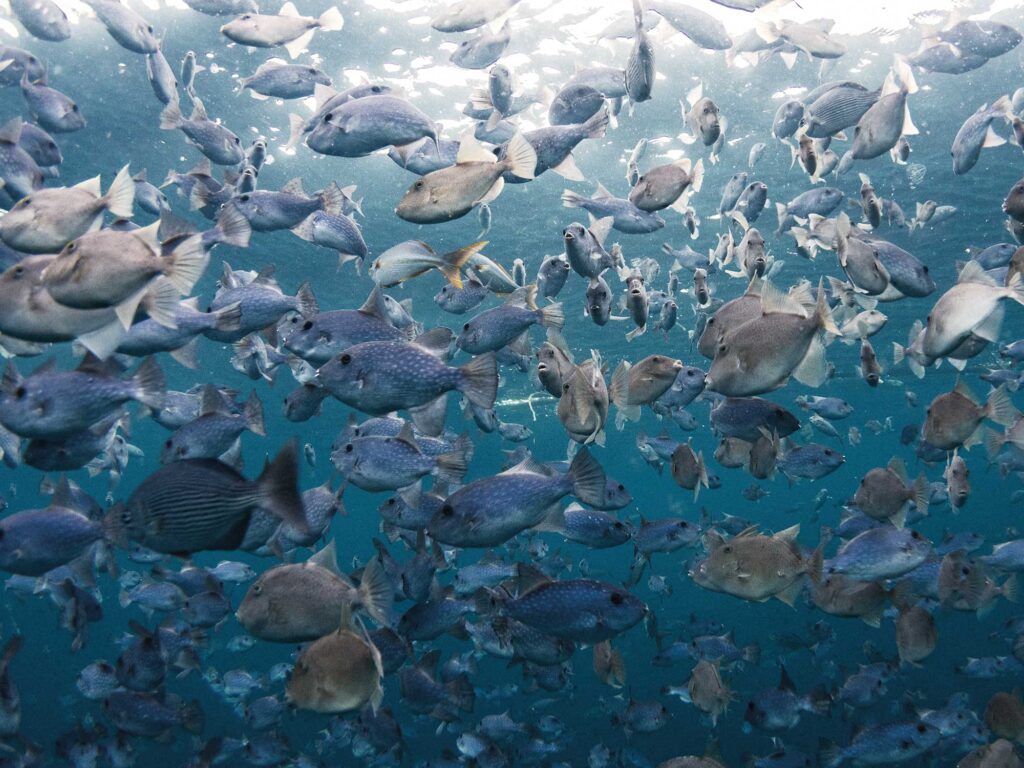 A floating pallet attracts myriad species looking for protection.
Adrian Gray
Live Baits Inshore and Offshore
A floating pallet attracts myriad species looking for protection.
Adrian Gray
Live Baits Inshore and Offshore
Each Sport Fish Panama Island Lodge boat is outfitted with a livewell and a complement of tuna tubes. When boats depart the lodge each morning, livewells are filled with live blue runners. These make great baits for roosterfish inshore, or offshore schools of yellowfins or dorado on floating logs. They can be slow-trolled from the center rigger while live-baiting blue water (a deadly tactic for sailfish or tuna). The fleet will often add to their day’s supply of blue runners if they happen upon a baitball (where the crew will take a scoop or two with a net).
Tuna tubes are a necessity here, for both inshore and offshore applications. The clouds of black bonito that congregate around high spots in the Gulf of Chiriqui attract and hold not just pelagics, but also nearshore gamefish. A spread of two live bonito offshore can catch black marlin, blue marlin, sailfish, dorado or yellowfins. Inshore, these same baits are go-tos for big roosters and cuberas. There are places, such as around Montuosa Island, where you can transition from fishing for black marlin to fishing for big roosterfish without reeling in your spread. (Only about 500 yards separates the waters where you’d target each species.) Wahoo can show up almost anywhere; it’s not unheard of for a wahoo to sky on a live bait, cutting the hapless creature surgically in two, which sometimes happens nearshore and offshore.
Ideally, anglers will get to enjoy the special yellowfin fishery in these waters and experience some of the great variety of gamefish here. Choices, choices.
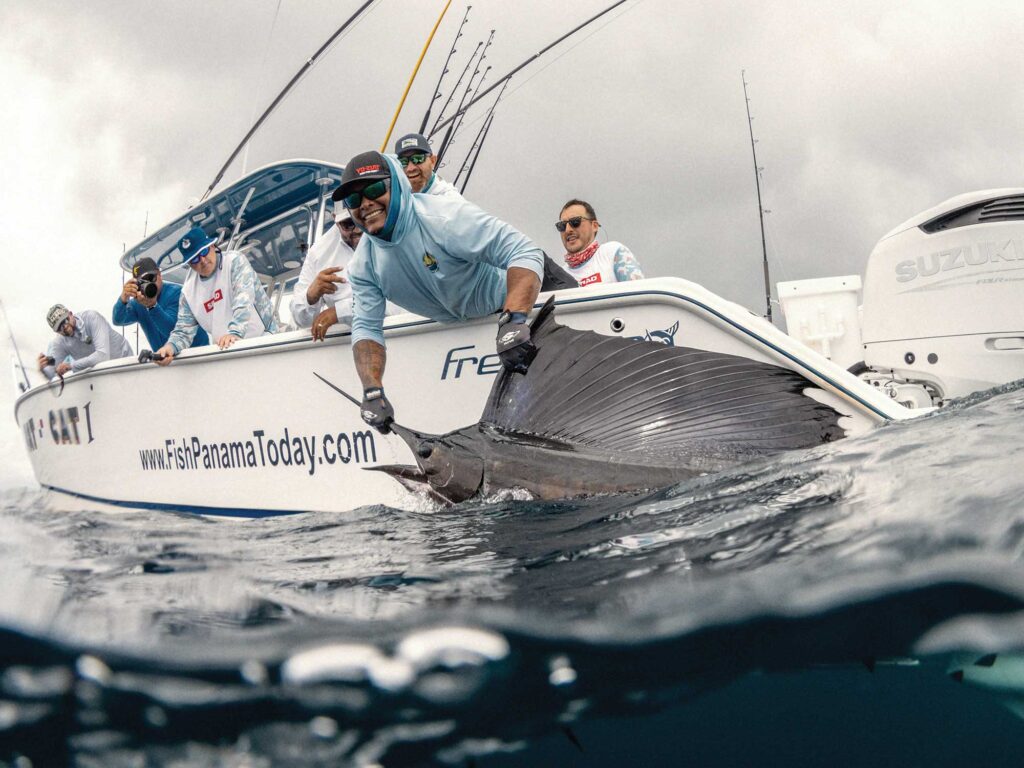 Sailfish cruise the deep blue water between the lodge and Coiba Island.
Adrian Gray
Tuna Frenzies
Sailfish cruise the deep blue water between the lodge and Coiba Island.
Adrian Gray
Tuna Frenzies
The diversity of abundant fishing opportunities in the Gulf of Chiriqui is irrefutable. The fact remains, however, that tuna fishing is so singular and exciting in the way it unfolds that there are times when chasing variety might miss the point. After all, there aren’t many places in the world where you can often see yellowfin tuna frenzies going on—not simply spotting tuna up top or a group of tuna chasing flying fish, but bona fide frenzies in which acres of the sea are churned white by yellowfins crashing the surface and slinging themselves completely out of the water. This spectacle happens here with some frequency. Of the three and a half days of fishing we enjoyed in May, we saw multiple.
Trip PlannerSport Fish Panama Island Lodge is located 12 miles off the coast in the Gulf of Chiriqui on Isla Parida. It accommodates 20 guests, who can fish in any of four 33-foot power cats making the run to iconic fishing spots such as Hannibal Bank and Isla Montuosa. Despite the remote location, guests stay in two- or three-bedroom luxury guesthouses with Wi-Fi, air conditioning and all the comforts of home.
The lodge handles all of the logistics for guests once they reach David, Panama. This includes airport greeting, a night in Panama City, domestic transfers and a ride to the island.
Bringing a load of rods and reels with you to the lodge isn’t necessary. Boats are outfitted with high-quality, heavy spinning tackle and a full assortment of conventional gear. You’ll find Accurate jigging outfits, Mustad jigs, and trolling and live-baiting reels in sizes 30, 50 and 80 with Blackfin rods. Each boat also carries an electric deep-drop outfit for fishing deep structure. The lodge’s assortment of lures is similarly thorough. Among those, Yo-Zuri Mag Poppers and Hydro twitchbaits are equally at home offshore on the advancing edge of a porpoise school (where you’ll find the tuna) as they are around ledges, pinnacles and rocky shorelines near islands.
The post Spectacular Yellowfin Fishing in Panama’s Gulf of Chiriqui appeared first on Salt Water Sportsman.
- Home
- About Us
- Write For Us / Submit Content
- Advertising And Affiliates
- Feeds And Syndication
- Contact Us
- Login
- Privacy
All Rights Reserved. Copyright 2025, Central Coast Communications, Inc.